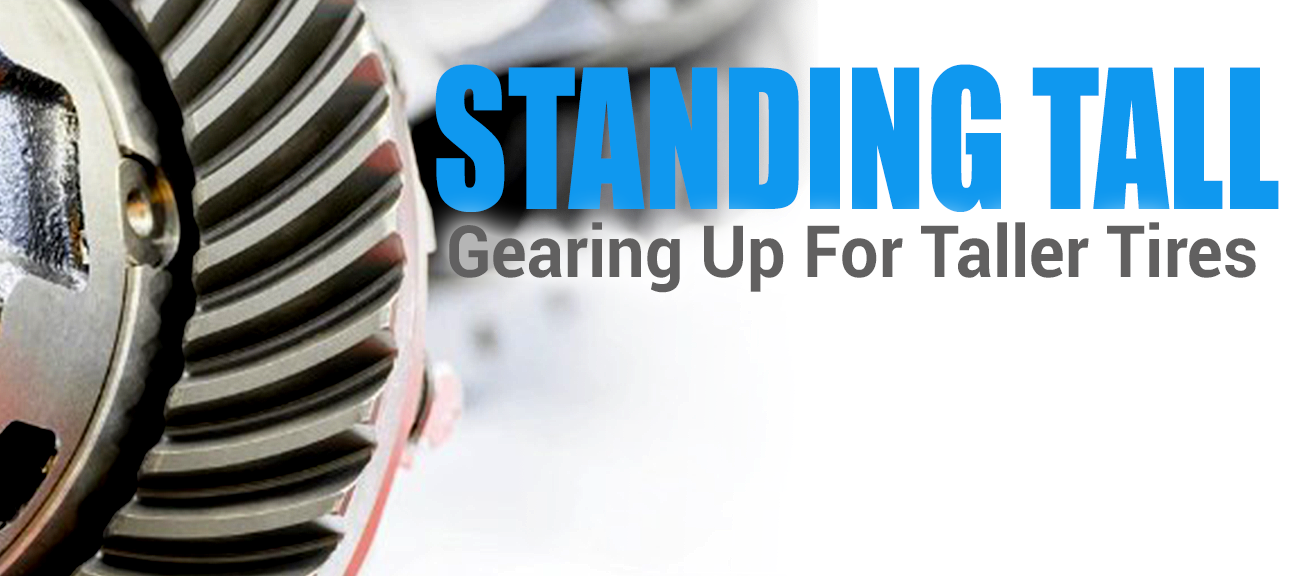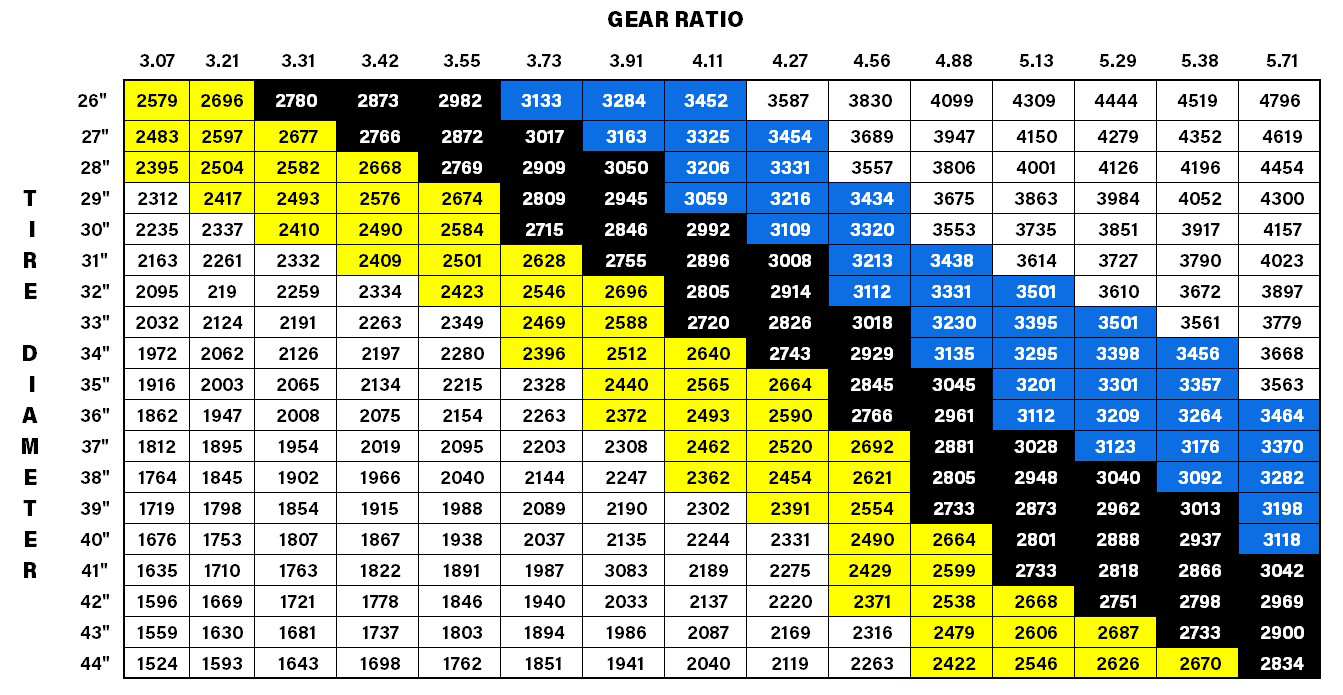
Courtesy of Superlift Suspension Systems - April 11, 2012
Whenever larger-than-stock tires are installed on a truck, it will have a direct effect on the truck's performance. Why? It is related to the effective gear ratio. Your truck comes from the factory with the optimum axle gear ratio to work with the truck's engine, transmission, and stock tire combination as well as provide a good balance between acceleration and fuel economy. When taller tires are installed on a truck, but the axle ratios stay the same, the effective gear ratio is reduced. This means the engine is forced to operate below its optimal power band, resulting in reduced performance and fuel economy. In order to restore the effective gear ratio (and the truck's performance), you'll need to have the axle gears swapped to lower (numerically higher) ratios.
Fortunately, finding the correct gear ratio to match the tires you plan to install is simple using a mathematical formula. There are several different formulas available to determine the proper ratio, varying in difficulty. The simplest and most reliable method we've found is to determine the engine RPM at which the truck operates with the stock gears and tires at a given speed, and then closely match this RPM with the larger tires. To use the following formula, you'll need to know both the stock axle gear ratio and the stock tire size. It also helps to know what RPM the truck runs at a given speed with the stock setup, but it's possible to find this information with the formula. Keep in mind that all RPM readings should be taken with the transmission in a 1:1 ratio (Fourth with most manuals or third with an automatic).
The Formula
2242 = 65 x 3.08 x 336 / 30
To illustrate, let's say we want to determine the correct gears to install when upgrading from 36" tires to a transmission with 3.08 gears and 30" tires in stock form. Since the truck doesn't have a tachometer, we first need to determine the RPM the engine is spinning at a given speed, such as 65 mph. With this information, the formula looks like this:
rpm = mph x gear ratio x 336 / tire diameter
At 65 mph, the truck's engine is spinning at 2242 rpm, which is right in the optimum power band for most V-8 engines. Now all that's left to do is plug in the new tire size and a couple of different ratios available for the truck to see which one closely matches the RPM.
2263 = 65 x 3.73 x 336 / 36
As you can see from the above formula, 3.73 gears with 36" tires is optimum for restoring stock performance with this truck. Keep in mind that not all ratios are available for every axle, so do some research to make sure there's a ratio close to what you need available for your truck's axles.
One More Thing To Keep In Mind
One last note - regarding trucks equipped with overdrive. The Overdrive gear in a transmission allows the drivetrain to operate at a ratio below 1:1, which reduces engine RPM and improves fuel economy when cruising on the highway. Most Overdrive gears run at a ratio of approximately 0.73:1. As mentioned earlier, the best option for individuals who primarily use the truck on the street is to match the formula provided above. However, Overdrive offers a unique opportunity for dedicated off-roaders. Since overdrive reduces the need for high gears at highway speeds, it's possible to "cheat" and select gears that are a little lower (numerically higher) for better slow gearing off-road without sacrificing highway drivability. This advantage becomes apparent when you do the math by multiplying a prospective gear ratio by the Overdrive ratio of your transmission. To illustrate, a 5.13 gear truck without overdrive and moderate-sized tires would offer astonishing slow-speed crawling ability for off-road situations. Still, it would leave the engine screaming at highway speeds. However, if the same 5.13s are installed in a truck equipped with an overdrive of 0.73:1, and we do the math (5.13 x 0.73 = 3.744), we find that the Overdrive gear gives the effect of a very streetable 3.73 ratio for highway cruising. In other words, the truck has the same good crawling speed of 5.13 gears (because Overdrive is never used off-road) combined with a very street-friendly effective ratio of 3.73 gears. Of course, the engine will still rev higher on the highway compared to having the proper ratios, which can be achieved by following the steps we outlined earlier. Overdrive offers dedicated four-wheelers the option of installing low, off-road-friendly gears, allowing them to drive on the street while maintaining some fuel economy. To plug overdrive into the gearing formula above, simply multiply the Overdrive ratio by the axle gear ratio.
The Chart
Although you should take the time to calculate the optimal ratio for your truck and tire combination, we've made things easier by compiling the following chart. This information will give you a general idea of what ratios to look for, but always discuss your gearing needs with a professional at your local shop before making a purchase.
The chart is divided into three categories. The RPM highlighted in black is optimum for the tire size and ratio combination. These will provide the best overall drivability. If you're looking for a ratio that yields better fuel economy for highway driving at the expense of some acceleration and overall performance, choose a ratio within the yellow shaded area. If you're looking for a ratio that will improve acceleration and towing power at the expense of some fuel economy, choose a ratio in the blue shaded area.

Note: This chart is based on engine RPM at 65 mph with the transmission in a 1:1 gear ratio (Third Gear with a three-speed manual, Fourth Gear with a four-speed manual, or Third Gear with an Automatic Transmission). Remember, the actual rpm indicated in the chart will be slightly higher (between 100 and 300 rpm) on vehicles equipped with an automatic transmission. This is due to the slip present in an auto transmission's torque converter.
Factors To Consider When Choosing A Gear Ratio
Transmission type: Manual transmissions typically benefit from a higher gear ratio (e.g., 5.13) compared to automatic transmissions.
Vehicle weight and power: Heavier or more powerful vehicles may require a slightly higher gear ratio to maintain performance and allow for adequate acceleration, particularly off-road.
Driving style: Daily driving and highway cruising may benefit from a more conservative gear ratio for better fuel economy, while off-roading or towing could benefit from a higher ratio to maximize torque.
Tire size: Larger tires require a higher gear ratio to compensate for the increased rolling circumference and ensure proper engine-wheel RPM synchronization.
Additional considerations:
Rule of thumb: A common rule of thumb is to multiply the tire diameter (38 inches) by 0.12, which results in approximately 4.56.
Torque vs. RPM: Higher gear ratios provide more torque to the wheels, which is beneficial for off-roading and towing. Lower gear ratios enable higher RPMs, which can improve performance on paved roads.
Availability: Gear ratios are not always available for every vehicle. It's important to research available ratios for your specific vehicle and axle.
For example, a vehicle running 38-inch (OD) tires, a gear ratio of 4.88 or 5.13 is generally recommended. Some sources suggest that 4.88 is a good starting point, especially if you have a manual transmission, while 5.13 might be better for heavier vehicles or those used in hilly terrain. The optimal gear ratio depends on your specific vehicle, driving style, and intended use (e.g., daily driving, towing, off-roading) when making your decision.
